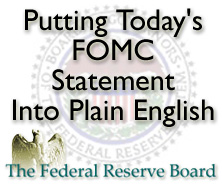FOMC Statement: Federal Reserve Discusses Rate Increase, But Concerned About Growth
 The post-meeting statement of the Federal Reserve’s Federal Open Market Committee indicated that while the Federal Reserve is considering raising its target rate as early as June, the agency is in no hurry to cast anything in cement. The statement cited stronger labor markets and low unemployment rates as encouraging, but noted that FOMC members remain concerned about economic growth due to low inflation failing to meet the FOMC goal of two percent.
The post-meeting statement of the Federal Reserve’s Federal Open Market Committee indicated that while the Federal Reserve is considering raising its target rate as early as June, the agency is in no hurry to cast anything in cement. The statement cited stronger labor markets and low unemployment rates as encouraging, but noted that FOMC members remain concerned about economic growth due to low inflation failing to meet the FOMC goal of two percent.
15 of 17 Federal Open Market Committee members said that they expected interest rates to increase before year-end, but downwardly revised forecasts of how high rates might be raised. Committee members further expressed concerns about economic growth and inflation, which is likely to impact Federal Reserve decisions about raising interest rates or not.
Economic Growth, Inflation Slower than Expected
The FOMC statement noted that economic growth has “moderated somewhat,” which was less enthusiastic than in January, when the Fed noted solid economic growth. The Fed revised its projections for the national unemployment rate from December’s expected range of 5.20 to 5.50 percent to 5.00 percent to 5.20 percent.
The target federal funds rate remains at a range of 0.00 to 0.250 percent and is expected to increase to 0.625 percent by year-end, and forecasted to reach 0.875 percent by the end of 2016. The target rate is expected to rise to 1.25 percent at the end of 2017.
Raising the target federal funds rate would impact mortgage rates, rates on vehicle loans and corporate loans. As the cost of loans rises, and wages stay relatively flat, consumers will have less cash for discretionary spending and may put off buying homes and purchasing big-ticket items that require financing.
Fed Chair Says Fed Isn’t “Impatient” about Raising Rates
After the FOMC statement was issued, Fed Chair Janet Yellen gave a press conference. Asked about the FOMC removing the word “patient” from its description of the committee’s attitude about raising the target federal funds rate, Chair Yellen said that removing the word patient does not mean that FOMC members are impatient about deciding when to move on interest rates.
Chair Yellen reiterated what’s she has said many times in recent FOMC statements and press conferences, that although the committee may project when it will raise rates, the decision will be based on incoming economic data.
In her opening remarks, Chair Yellen said that when the Fed does raise its target interest rate, the FOMC will retain a “highly accommodative” stance in line with the FOMC’s dual mandate of achieving maximum employment and a target inflation rate of 2.00 percent.
All in all, this FOMC statement and Fed Chair Janet Yellen’s press conference revealed no great changes in the Fed’s stated policy over the last several months. While low unemployment rates are prompting the Fed to consider raising the federal funds rate, no date for doing so has been set; the agency will provide plenty of advance notice before it raises rates and in the meantime will closely monitor domestic and global financial and economic developments for guidance in deciding when to raise rates.

 When applying for a new home mortgage, many loan applicants initially consider applying for a 30-year fixed rate mortgage. This is perhaps the most common and traditional type of mortgage available. It allows you to enjoy the opportunity to pay for your home over the course of 30 years with equal payments every month. While this is one option, there are actually multiple choices available. For some applications, a variable rate mortgage may be more advantageous. If you are comparing the options between a fixed rate and a variable rate mortgage, you may consider a few points.
When applying for a new home mortgage, many loan applicants initially consider applying for a 30-year fixed rate mortgage. This is perhaps the most common and traditional type of mortgage available. It allows you to enjoy the opportunity to pay for your home over the course of 30 years with equal payments every month. While this is one option, there are actually multiple choices available. For some applications, a variable rate mortgage may be more advantageous. If you are comparing the options between a fixed rate and a variable rate mortgage, you may consider a few points. When you initially start shopping for a home mortgage, you may be drawn to advertisements for ultra-low interest rates. These may be rates that seem too good to be true, and you may gladly contact the lender or mortgage company to complete your loan application. However, the unfortunate truth is that all too often, mortgage applicants are unpleasantly surprised and even disheartened to learn that they do not qualify for the advertised interest rate. By learning more about the factors that influence your interest rate, you may be able to structure you loan in a more advantageous way.
When you initially start shopping for a home mortgage, you may be drawn to advertisements for ultra-low interest rates. These may be rates that seem too good to be true, and you may gladly contact the lender or mortgage company to complete your loan application. However, the unfortunate truth is that all too often, mortgage applicants are unpleasantly surprised and even disheartened to learn that they do not qualify for the advertised interest rate. By learning more about the factors that influence your interest rate, you may be able to structure you loan in a more advantageous way.